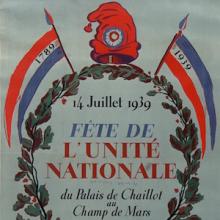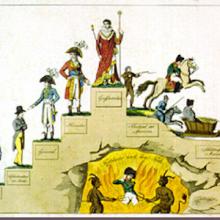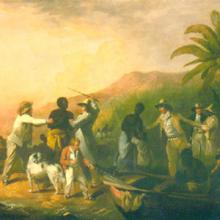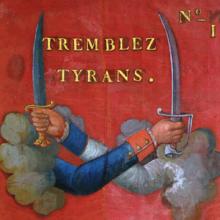Popular Culture

Source Collection: Legacies of the Revolution
The powerful influence of the French Revolution can be traced in the reactions of those who witnessed the event firsthand and in the strong emotions it has aroused ever since.

Mr. de Lafayette, Commander of the Paris National Guard, Receives the City’s 'Sword for the Defense of Liberty'
During the French Revolution the most visible connection between America and France was Lafayette, who had volunteered for service in the American Revolution and had been mentored by Washington and Jefferson.

Source Collection: The Napoleonic Experience
The bare facts of the life of Napoleon Bonaparte stagger the imagination and rival the plots of the most fantastic novels.

Six Part German Caricature: Napoleon Is Now Reduced to a Manageable Size!
Napoleon is mocked through this diminutive portrayal of the former conqueror.
Original Format
Engraving
Physical Dimensions
18.8 x 25 cm

Triumph of Napoleon, First Consul
Napoleon encouraged comparisons between the post-revolution French republic and the Roman republic. The French adoption of the term "Consul" was a clear reference to the Roman Republic, for that was the name given the men chosen to direct the republican government in Roman times.

Source Collection: Slavery and the Haitian Revolution
Since the revolutionaries explicitly proclaimed liberty as their highest ideal, slavery was bound to come into question during the French Revolution. Even before 1789 critics had attacked the slave trade and slavery in the colonies.

Source Collection: War, Terror, and Resistance to the French Revolution
One fault line that has divided inquiries into the Terror has been its connections to the democracy introduced in 1789.

British Liberty Tree
These painted engravings ridicule the unrest wrought by French revolutionaries by contrasting French subversion with British stability.

Bonaparte Visiting the Hospital in Jaffa
This undated post-French Revolutionary print shows Bonaparte visiting a hospital in Jaffa. Of classical proportions, this image is centered on Bonaparte, who appears to be bringing order to an otherwise disorderly and chaotic scene.

Festival of Supreme Being
These depictions show the Festival of the Supreme Being during the French Revolution, a massive pageant staged by Jacques–Louis David on 8 June 1794, in open air on the "Field of Reunion," formerly the royal army’s parade ground.